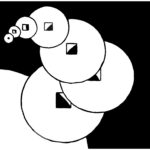Romans 12:2 tells us that we need to not conform ourselves to the pattern of this world. It teaches us that we do that by transforming by the renewing of our minds.
The battle for control of the person is in the mind. Every person follows a pattern. The pattern they follow began early in their lives. The pattern could be the result of trauma and distress, or a loving and healthy environment. In either case, the reality is that a pattern was established. Patterns are developed due to intentional, random, or event-based reinforcement.
Intentional reinforcement is where the reinforcement was planned and purposefully done. An example of this can be where the parents identify the abilities and propensities of their child and then intentionally find ways to reinforce those abilities and propensities, such as paying for singing lessons for a child who shows interest and skill in that area. For example, the parents reward their children for treating each other with respect; rewarding the inclination can develop it into a character trait. A less healthy example would be as in extreme Islamism, a child would be encouraged and rewarded for developing the willingness to blow himself up and kill others in the name of Allah.
Random reinforcement is where the reinforcement happens randomly. For example, the person who buys lottery tickets and “wins” on occasion will keep spending larger amounts of money that what he “wins” because he believes that the random times he “wins” are indicators that he will eventually win the big one. For example, the husband may be abusive physically with his wife. He may batter her at times with no clear reason for the violence. Afterward, he will be telling her how terrible he feels about what he did, and may even buy her flowers and gifts. At other times, he may hit her, and not buy gifts for her. The goal here is to keep her off balance, never really knowing what to expect next.
Event-based reinforcement is where the reinforcement happens when an event occurs. For example, when a father sexually molests his daughter. With constant repetition, it develops certain negative responses in her that will manifest throughout her life when some other event reminds her of her father’s behavior. Patterns may change often throughout one’s life, and intentional, random, and/or event-based reinforcement will continue to shape the pattern of the person. The goal of the counselor is to help the client learn this and to take intentional control of the shaping of the pattern for the benefit and health of the client.
Change the way one thinks
Romans 12: 2 tells us the steps that are required to accomplish this. We are to transform by the renewing of our minds. People change when their minds change. The counselor cannot change the mind of a client, but the counselor can lead the client to the truth.
The Trap
A lie can seem as real as the truth to the person who believes it. For the most part, every client believes some lie. This lie could have been the result of some past event, trauma, or reinforcement. Regardless, the client is struggling with what they either believe to be the truth or want to believe is the truth. The question of a client to her counselor offered an example, “Grown men are supposed to act like adults, right?”
The question implies that all adult males are automatically going to behave as mature individuals just because of their age. As well it demonstrates a naivety on the part of the woman. Just because someone believes that something is true, that does not make it true. It is these lies that we develop and internalize that can blind you and cause you to live trapped in an unhealthy and disastrous pattern. What the client needs at this point in their lives is freedom. The Scriptures tell us that the Truth will free us.
John 5:3-9 (NLT) tells the following story about a pool where people believed that an angel would come and disturb the water. The idea was that when the water was disturbed, the first sick person to enter the pool would be healed. With this in mind, the Bible says, “Crowds of sick people—blind, lame, or paralyzed—lay on the porches. One of the men lying there had been sick for thirty-eight years. When Jesus saw him and knew he had been ill for a long time, he asked him, “Would you like to get well?” “I can’t, sir,” the sick man said, “for I have no one to put me into the pool when the water bubbles up. Someone else always gets there ahead of me.” Jesus told him, “Stand up, pick up your mat, and walk!” Instantly, the man healed! He rolled up his sleeping mat and began walking!
This passage is a great example of how the Truth will set someone free. Notice Jesus asked the man IF he wanted to get well. Why did He do that? Because many times clients will cry and tell you how much they want things to change and improve, but then when you start telling them the steps they need to take for those things to happen, they do not do them.
Change is not change until there has been change.
Jesus did not have long conversations with the man about why other people would or would not help him get into the pool. Jesus knew that this man’s answer was not be found in the pool. The root problem with this man was what he believed. He was convinced that the pool was his only chance at a real healing. Instead, Jesus spoke the truth to him, by saying, “Stand up, pick up your mat, and walk!”
This statement included three components: It was a challenge to the man on his erroneous beliefs concerning the pool. If he tried to get up, then he would have to argue with why he had been laying there for so many years.
It was a test to see if he would even make an effort to try to stand. Many times the clients want answers, but not answers that will force them to change. They want you to tell them what the other person (the one who they think has the “real” problem) has to do to fix things.
It was also a way of trying to identify his motives and excuses for continuing to believe as he did. Too often, when you help the client come to the truth, they realize the sacrifice and effort they will have to make, and they do not want to go on.
Imagine how this man’s life will change once He obeys Jesus, and gets up and walks. He now has to get a job, pay bills, cook and feed himself, wash his own clothes, and bathe himself. This and so many other things are enough for some people to choose to live with illnesses and problems. The man had to hear the truth, choose to accept it, believe it, and put it into action. That is the formula for changing the pattern of a person.
Belief Therapy works in the same manner. We want to learn as much as possible about the client during our sessions, but we also want to find the real answer for them. To accomplish this, we must follow a clear pattern of therapeutically effective counseling.
Know Where You Are Headed
The most important is where you are heading with this client, and how it may be different from with other people you counsel. The answer to that is to reach a point where clients understand, as much as possible, the factors that got them on the unhealthy pattern they have been living. Learn new behavior that will get them started on the new healthy pattern. (In addition, where possible) Come to a closer walk in their relationship with our Lord.
The Client’s Responses to Events.
Whether the person is aware, or not, that they are personally responsible for their own beliefs, even as a result of a painful and/or undeserving event, they must eventually make that connection and learn to choose their present responses in a healthier manner. The principle is found in Galatians 6:7, “Do not be deceived, God is not mocked, for whatever a man sows he will also reap.”
The principle is this: It is not what happens to us or what we do, but how we define ourselves because of those things, which shape our lives from then on.
How does this work? The mind is the crucial part of the puzzle. As the mind goes, so goes the person. What we believe controls how we feel. How we feel, affects our actions. The result of our actions will produce a pattern in us. That pattern can control our thinking about things. And so on.
The graphic on this next page demonstrates the process in good detail.
If the person really wants to change, then he must change the way he thinks.
However, to accomplish this, the client must first start changing his behavior and actions.
As he changes his behavior and actions, he will start modifying his self-perspective and life pattern.
This will cause his thinking to adjust to the new behavior, and start producing healthier thoughts and decisions.
As this happens, the client’s feelings and emotions will change as well. He will start to feel better about himself and others.
This will cause him to behave more healthily, and so on.








